Hockey drills
There is a square just outside the 23 in the middle.
3 teams between 4 and 6 players.
- Team A starts attacking from the right, trying to score;
- Pay attention to scoring positions (guard, spot, 2nd pole);
- If team A scores, the coach throws in a bonus ball
- If the ball goes out, it is for team B(defence)
- Team B's task is to play into team C's position;
- Team C then moves the ball to the right and starts attacking.
- Team A then goes to defend
- A plays the ball to the incoming B
- B rebounds the ball
- A drives a little
- B offers himself wide and A plays the ball into the space to B
- Because of B's running action outside, C makes space by running inside.
- B accelerates during his running action with the ball over the back line.
- C has gone towards the dot
- B passes, C rounds off (one-touch).
Variation: Exercise 2x.
Start with a three-run.
- A floats with the ball, when A is halfway, he pushes the ball out of the run to B.
- B does the same (to C)
- etc.
- Apply differentiation.
Possibly after this warm-up play another game of possession.
Goal
:To be able to quickly switch between offense and defense.
Format
:The field between the 23m line and the halfway line is divided into two parts. There are three teams of 3 players. Two teams play against each other, the remaining team has a break.
- Team 1 and 2 play against each other. Goal of team 1 is to score, goal of team 2 is to get the ball to team 3.
- When one team scores, the other team has to start the next game as defender. E.g. Team 1 scores against team 2, then team 2 plays as defensive team against team 3.
- When team 2 has taken possession of the ball, they play it to team 3. Team 3 starts attacking team 1 as soon as they receive the ball. Team 1 must then switch from attack to defence. Team two now takes the place of team 2 and awaits the play between 3 and 1.
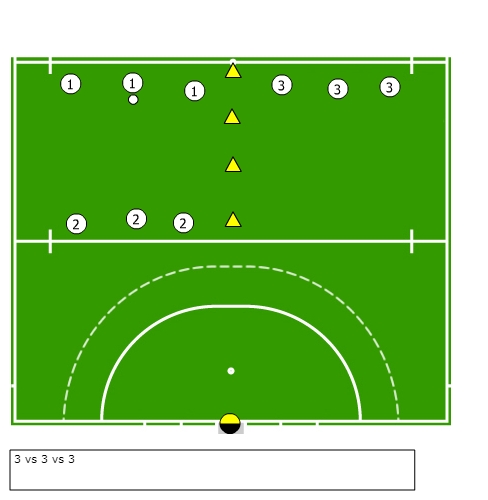
Variations:
- The number of players per team can be adjusted.
- The field can be made narrower.
Points of attention:
- The game should continue as much as possible. To do this, it is useful to have a lot of balls with you as a coach so you can throw them into the exercise.
Purpose
: To get warm through a combination of passing, running, and picking up in the run and from standstill.
Format
:This exercise is also known from volleyball. The pawns are not exactly in a triangle. It is possible, depending on the number of players, to set up a multiple of the exercise.
- The player at A passes the ball straight to the player at B.
- The player at B plays the ball to the player at C and runs towards point A.
- The player at C receives the ball at point D and passes it to point A.
- For the changeover, A runs to B, B via D to C and C to A.

Variations:
- Variations can be made in terms of stroke. (hit, push, flats)
- The distances can be made larger or smaller to adjust the level of difficulty.
- Pawns can be placed to play in between. This is to increase the purity. When you make the cones smaller, the degree of difficulty increases.
- To play the ball from C to D there can be bounced.
- To play the ball from D to A you can play bounce.
- You can also place point C on the other side so that you reverse backhand and forehand.
- When you place point C at 90 degrees from point B, you can do the same exercise, only then you will hit point D from a different angle.
- When you set up different situations, you can rotate the exercise. Situation A is the standard, in situation B the exercise is mirrored, in situation C the exercise is set up so that point B and C are at 90 degrees from each other and situation D is a mirror of situation C.
Points of attention:
- As a trainer you can take a good look at the different techniques of your players.
- Sit low at the take-off.
- When playing the ball from C to D, the ball may not shoot too far in the direction of A. The intention is that the player coming from B should take the ball at right angles.
- Play the ball on the forehand where possible.
- Stand ready to receive the ball. (low to the ground, stick on the ground)
Purpose
: Various technical forms to warm up.
Format
:The exercise can be set up one-sided or two-sided. This depends on the number of players in the training.
- At point A, the player makes a drag and passes the pawns. Then he passes to the player at point B.
- The player at point B takes the ball and dribbles to point C. From there he passes to the player at point C.
- The player receives the ball and turns towards the goal, completing the pass
- Before turning, you run after the ball. Point D rejoins point A again.
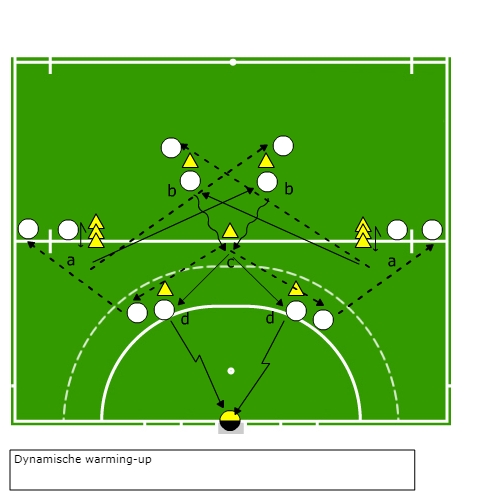
Variations:
- You can set up the exercise single-sided and double-sided.
- You can also choose to warm up the goalkeeper in this way.
- At C, you can switch sides. If you are coming from the right, play the ball to the right, so that you can practise from both sides.
Points of attention:
- This is a good time to look at different techniques of your players and polish them.
- When turning and dribbling, the ball must stay on the stick.
- There is only one point at C, so players should not get in each other's way and look for the next ball to enter play.
- All balls are played into the forehand of the teammates.
Goal
:To increase ball skills by alternating between playing without and with the ball, floating, hitting and bouncing.
Set-up
:A square just outside the circle is set up.
- The player outside the square plays the ball into the square.
- The ball is accepted by player 1. He takes the ball and drives around the pawn to point C.
- At point C he plays the ball into the square to player 2 and runs on to point D.
- Player 2 plays the ball to point D so player 1 can pick up the ball there.
- Player 1 walks to the edge of the circle and shoots at the goal from inside the circle.
- Before turning, player 1 takes the place of player 2; Player 2 goes to play the ball; The player who played the ball in becomes player 1.
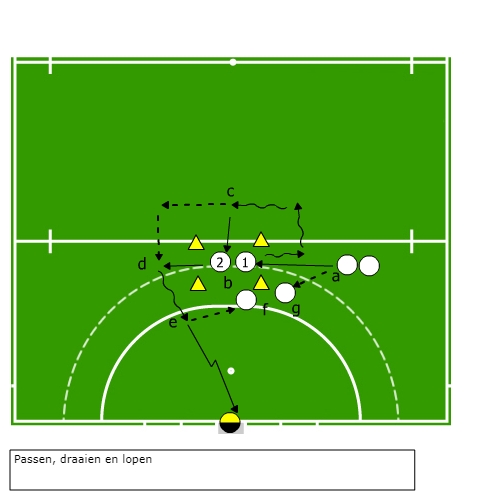
Variations:
- Instead of shooting at the goal, you can also tip the ball in.
- Player 2 can play and pass instead of taking the ball.
- The exercise can also be played from the other side.
Points of attention:
- The ball stays on the stick. When the ball is attached to the stick it is almost impossible to take it away without a foul.
- Player 2 must play the ball in the right direction.
- To make sure the exercise runs smoothly, there must always be a reserve player at points F and G.
Purpose
:The purpose of this exercise to learn how to link up with a defender to create space for your teammate.
Set-up:
- The player at B runs in from point C to point D. From there he runs towards point E.
- When the player coming from point B passes station C, the player from F runs towards point B.
- The player standing at A passes the ball to the player coming from F.
- The player who receives the ball plays the ball on towards point E.
- From point E the ball is driven through the pawns.
- Turning around goes as follows. The player coming from F stays on point B. The player from B goes to point A and the player from A goes to F. The defenders only turn around; B goes to F and F goes to B to defend.
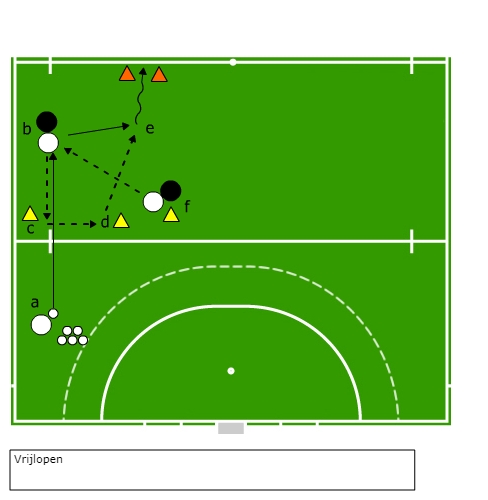
Variations:
- The exercise can also be performed in mirror.
- The exercise can also be played in the direction of the goal with the intention of scoring.
- The exercise can be played with or without defenders.
- The defenders can defend passively or actively.
- The exercise can be linked to the exercise "Overtal on take-off". This also changes the passing game!
- The player who receives the ball from A can also pass the ball to increase speed.
- The players from F can also make a sprint, the one who can take the ball can pass to E.
Points of attention:
- Defending can quickly become boring.
- If the pass from A is not going well, make the distance smaller.
Purpose
:The purpose is to teach you how to make space for your teammates by claiming a defender to you.
Set-up:
- It looks like the player at point A is going to take the ball out, but instead of doing so he leaves the ball and runs to point C.
- At the moment that the player at A runs away, the player at point B takes over his position.
- The player with the defender at point C runs in as soon as he sees the player at point A leave the ball and run towards him.
- The ball is taken out towards point D.
- At point D the ball is taken out and played to point C. After playing the ball this player walks to point E.
- The player now at point C plays the ball to the player running to point E.
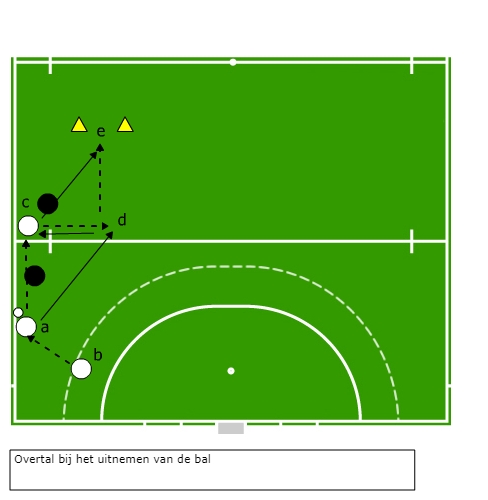
Variations:
- You can also mirror the exercise on the other side.
- When D can bounce the ball instead of taking it and playing it, the speed increases significantly.
- When C can also rebound, this increases the speed and effectiveness
- You can also give the C defender a more active role by having him try to get in front of his man.
Points of attention
- The smoother the exercise runs, the harder it is to defend it.
- Passes must be accurate for the exercise to be successful.
- Because there are many changes of position, it is important that you explain the exercise step by step.
Goal
:As an attack is to get the most out of your attackAs a
defense is to defend smartly.
Set-up:
- The field is up to the dotted line.
- The attackers take the ball from somewhere on the dotted line and must try to score.
- The defenders must try to defend the ball from the outside.
- The attackers score 3 points when they score; 2 points when they force a corner and 1 point when they have a good scoring chance.
- The defenders get 3 points when they defend the ball by playing in between the pawns; 2 points when they get a free hit and 1 point when they manage to play the ball over the touchline.
NB When defenders score, the ball does not have to be run between the pawns or accepted behind the pawns.
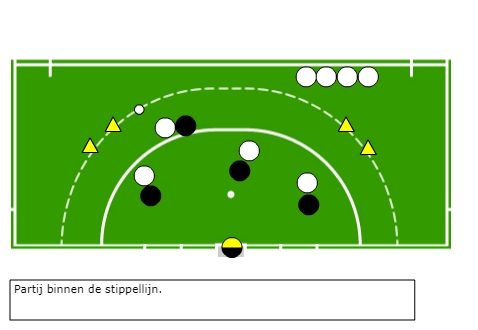
Variations:
- Adjust the size of those teams according to the amount of players available. You can also have one team on the sidelines and play a 2 to 3 minute game each time. That way there is a break and the players have time to discuss and analyse.
- The scoring pawns for the defenders can also be made smaller.
- You can play with a 'chameleon' and thus give the attackers an overtal when scoring is not going well.
Points of attention:
- Make sure it is clear who is picking up which man.
- As defenders, try to keep a low profile and prevent fouls.
- As the attackers, try to actively look for a foot.
- Look for opportunities to double-team When you, as the defender, realise that your man is not being active enough in the attack, help your buddy defend and push the attacker into a corner
- As the attacker, look for the backhand of your opponent. A right-wing attack is therefore often easier to execute than the other way around
Goal
: Searching for the flanks instead of passing the ball through the middle of the field. Teams will look for solutions and tend to shift the game. The % of ball possession will also go up.
Set up
:Two teams are made. The size of the teams depends on the number of players available. In the middle of the field there is a square or rectangle which marks where both ball and player may not pass.
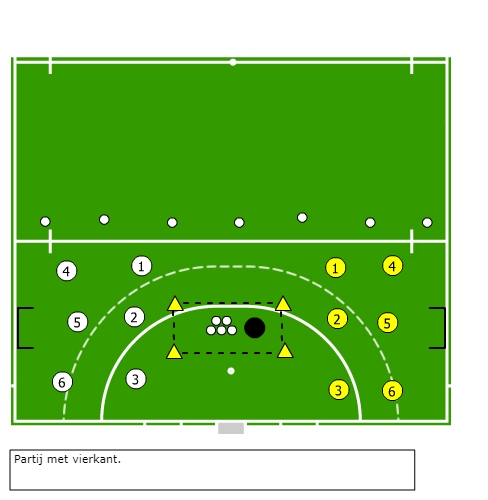
Variations:
- You can change the size of the square or rectangle to adjust the difficulty. The bigger this field, the more difficult it becomes.
- You can agree that you can walk through the field, but that the ball cannot pass through.
NB Make sure that there are no objects in the box and preferably use flat cones to prevent tripping up. - If there are an odd number of players, you can play with a 'chameleon'. This player will join the attacking team and change roles all the time.
- Place balls at the side of the field, so that when a ball is out, a new ball can be picked up to continue play.
- As trainer, stand in the middle of the field and coach both teams.
Goal
: The goal of this exercise is to actively pass between the ball and the defender, making yourself playable
Set-up
:In order to run this exercise properly, you need a minimum number of players. You can play with this when you make the exercise one station shorter.
- The player at B starts walking and runs with a curve past the orange pawns. By doing so, he offers himself for play.
- The player at A plays into the run-in player and runs around the indicated cones towards point B.
- The player with C runs in a curve around the orange cones. The moment of starting is important. He pays attention to how far the player at point B is.
- The player at point B plays into the player who left from point C.
- The player at point C receives the ball in front of the orange cones, runs with it into the circle and rounds the goal.
- The player who completed runs around the cones back to point A.
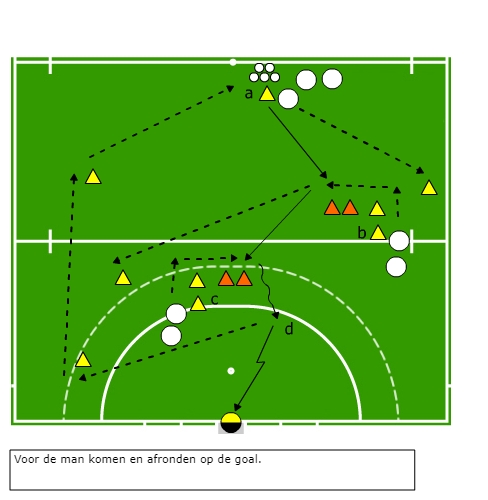
Variations:
- By removing one station, you can make the exercise smaller, requiring fewer players.
- The position from which the player who passes runs in front of the man starts can be changed. You can e.g. move point B more to the inside of the play area, making the direction of play different.
- You can also create an extra station near the goal for someone who is about to tip in Please note that you will need several players for this.
Points of attention:
- When floating, the ball is attached to the stick. This makes it almost impossible to take the ball away without committing a foul.
- When offering the ball, you have to make yourself wide so you can get between the ball and the defender
- Starting the run can be difficult to time, so pay extra attention to this
- The passes should be made in front of the orange cones, so that you are clearly running in front of the man







